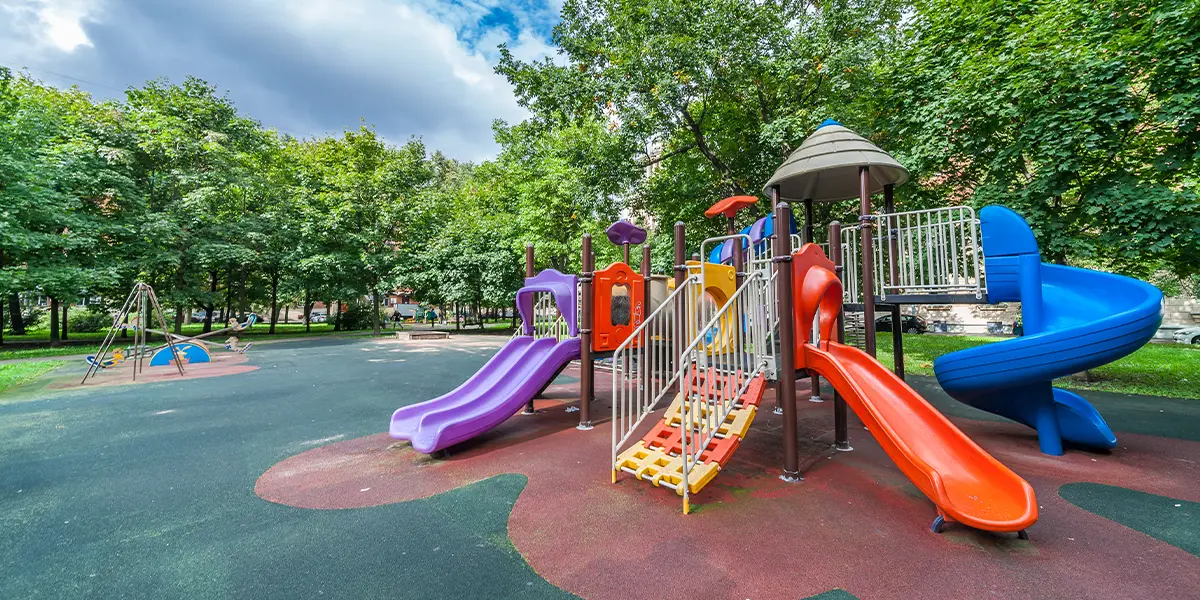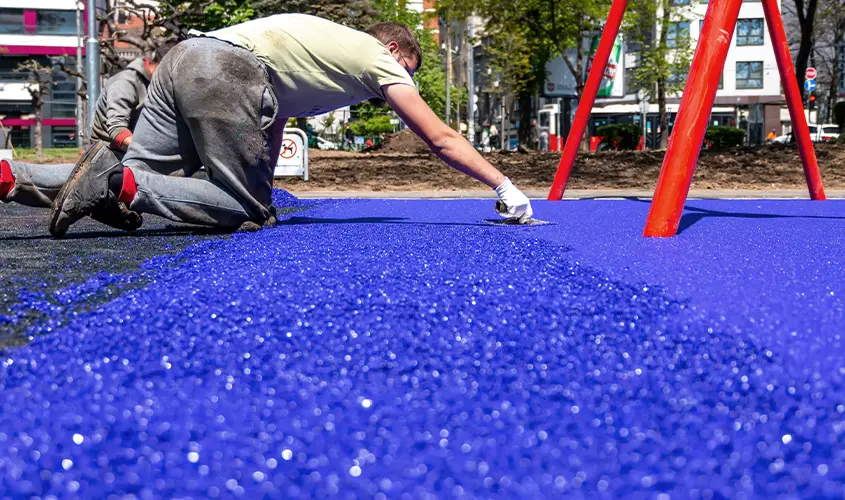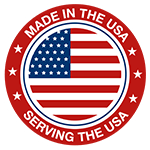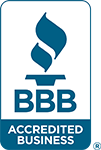Playground Surfaces for Schools – A Complete Guide
For schools building or upgrading a playground, the surface is just as important as the equipment itself. The right surface can make a big difference in terms of safety, accessibility, maintenance, and overall student experience.
At American Greens, we’ve worked with countless schools across the country, and we’re here to tell you what you need to know. Here are your options, the pros and cons of each, and additional considerations for choosing the best solution for your school.
Types of School Playground Surfaces
Not all playground surfaces are created equal, and some are much better suited for school use than others. Below are the most common surface types you’ll find in educational settings today, starting with synthetic turf.
Synthetic Turf
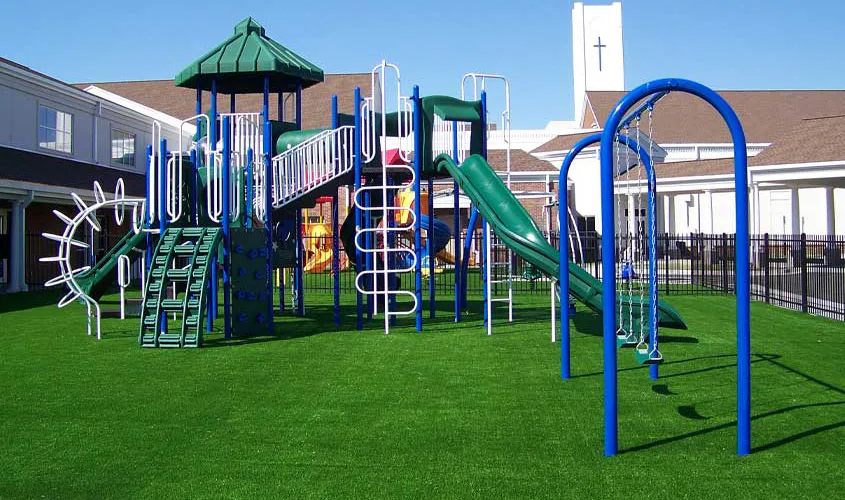
Synthetic turf is a popular option for schools looking for something that looks like grass but holds up better to heavy use. It stays green year-round, requires almost no maintenance, and doesn’t turn muddy after a rainstorm. When installed with proper padding, it can meet both safety and accessibility standards.
- Pros
- Low maintenance
- Consistent appearance and performance across seasons
- Drains quickly and stays usable after rain
- ADA accessible with proper installation
- Cons
- Higher initial cost
- Can get hot in direct sun without shade
For schools, synthetic turf is especially useful in multipurpose play fields or areas where a natural look is desired without the upkeep of real grass. It’s clean, safe, and easy to manage throughout the year.
Poured-in-Place Rubber
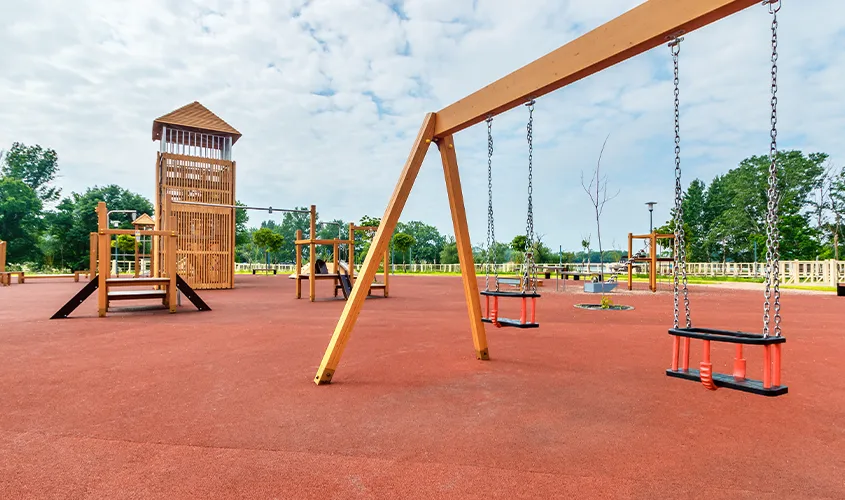
Poured-in-place (PIP) rubber is a seamless surface made from layers of rubber material mixed and poured directly on-site. It’s known for its shock absorption, safety ratings, and ability to be customized in colors or patterns.
- Pros
- High impact protection (critical fall height compliant)
- Fully ADA accessible
- Custom designs and color options
- Long-lasting with proper maintenance
- Cons
- Expensive to install
- Can show wear in high-traffic areas over time
Schools often use PIP rubber in high-traffic or high-impact zones, such as beneath swings or climbing structures. Its seamless design also makes it ideal for inclusive play environments.
Rubber Tiles
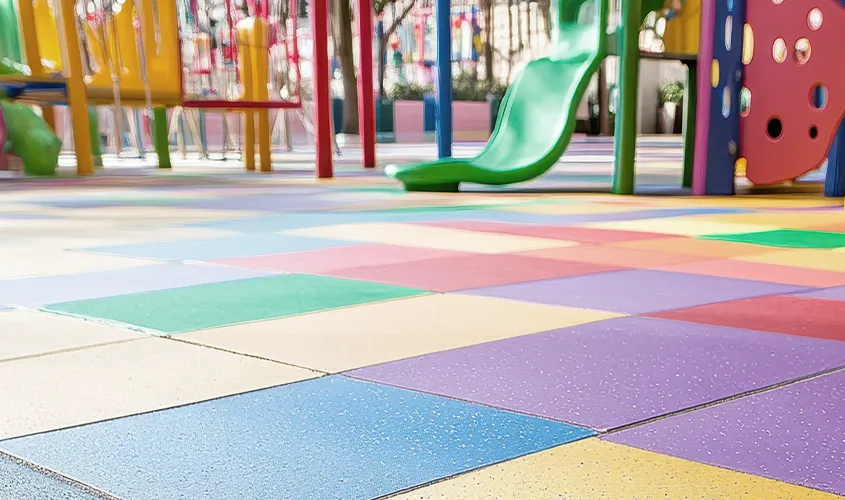
Rubber tiles are interlocking units that form a cushioned surface. While not as seamless as poured rubber, they’re easier to replace in sections, which can be helpful in schools where maintenance needs to be quick and cost-effective.
- Pros
- Easy to repair or replace damaged sections
- Good impact absorption
- ADA compliant
- Cons
- Tiles can shift or separate without proper installation
- Joints may be more noticeable
Schools that choose rubber tiles often do so for their balance of safety and ease of maintenance. They work well in smaller play areas or locations where repair flexibility is a priority.
Engineered Wood Fiber (EWF)
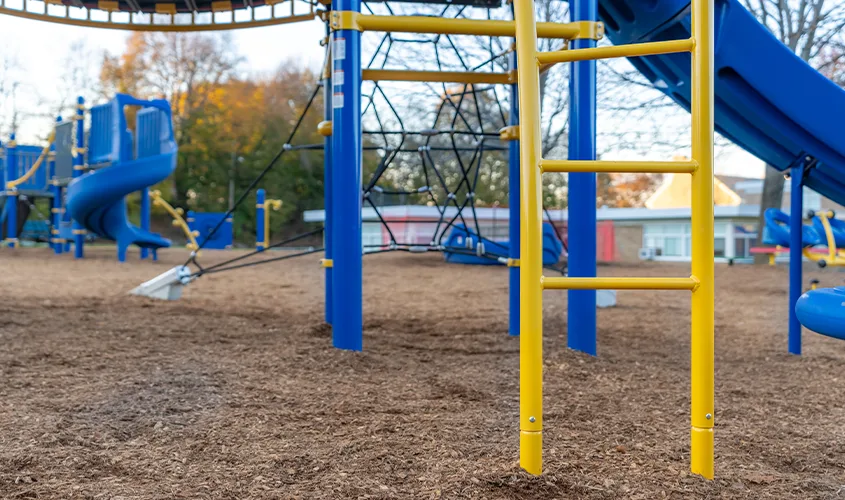
Engineered wood fiber is a processed type of mulch specifically designed for playgrounds. It’s affordable and effective at absorbing impact—if properly maintained at the right depth.
- Pros
- Lower upfront cost
- Natural appearance
- Good fall protection
- Cons
- Requires regular raking and replenishing
- Less accessible for mobility devices without special surfacing underneath
- Can decompose or attract debris over time
For budget-conscious schools, EWF is often a go-to option. However, it does require more attention over time to remain safe and compliant.
Loose-Fill Rubber Mulch
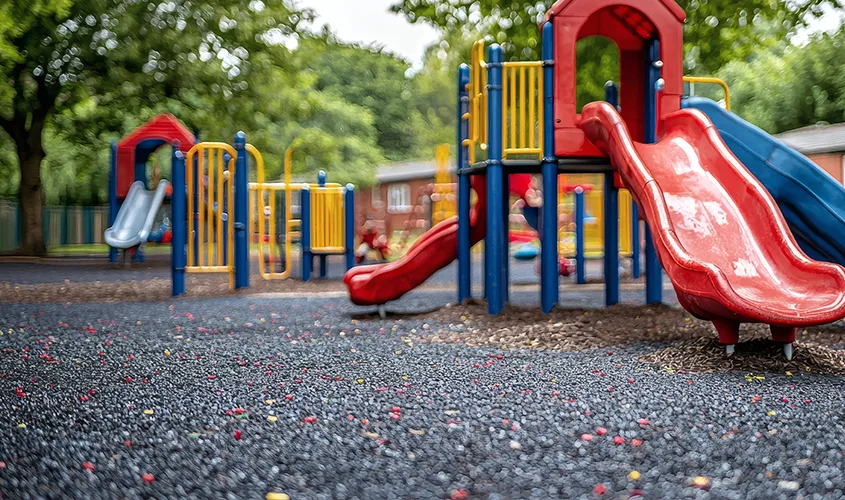
Rubber mulch is made from recycled materials and offers a more durable alternative to wood fiber. It won’t rot, and it stays in place better than natural mulch—but it can still shift with heavy use.
- Pros
- Doesn’t decompose
- Good shock absorption
- Low maintenance compared to wood mulch
- Cons
- Can scatter and require containment borders
- Not always ideal for wheelchair users
- May pose a choking hazard in toddler areas
Loose-fill rubber is a practical option for schools looking for an upgrade from wood without going all the way to a unitary surface.
Bonded Rubber Mulch
Bonded rubber mulch gives you the natural look of loose mulch but with a stable, bonded surface that stays in place. It’s essentially rubber mulch held together with a binder that creates a unified layer.
- Pros
- Lower maintenance than loose-fill options
- ADA accessible
- Visually natural but safer and more consistent
- Cons
- Fewer design options than poured-in-place rubber
- Mid-range cost
Schools often choose bonded rubber when they want the look of mulch with fewer maintenance demands and better accessibility.
ADA Compliance & Accessibility
Playgrounds built on school property must comply with the Americans with Disabilities Act (ADA), which requires that surfaces be firm, stable, and slip-resistant. While most surfacing options can meet these standards, some—like engineered wood fiber or loose-fill mulch—require more maintenance to stay compliant.
Unitary surfaces like synthetic turf, poured-in-place rubber, and rubber tiles offer the most reliable long-term accessibility. They’re ideal for wheelchair users and others with mobility challenges, which is essential in creating inclusive play environments.
Durability and Maintenance in School Settings
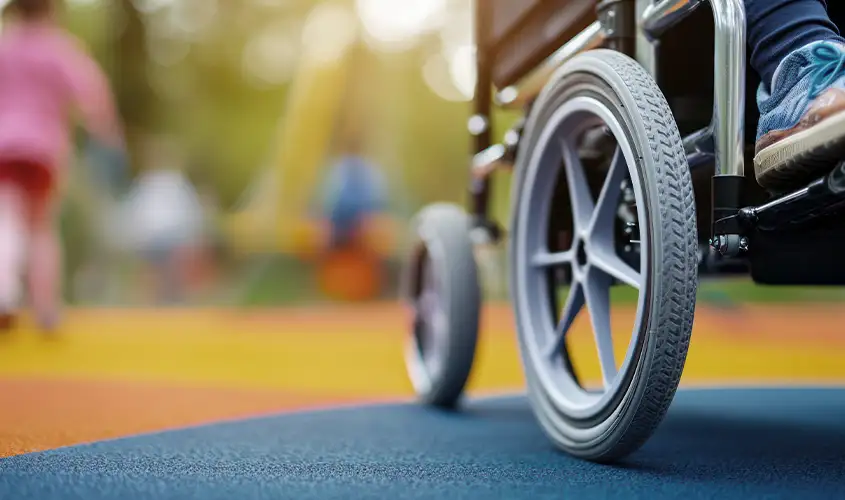
School playgrounds see heavy daily use, often in all types of weather. Because of this, durability matters as much as cost. While wood fiber may be affordable to install, it tends to need frequent top-offs and raking. Unitary surfaces cost more up front but typically last longer and require less maintenance.
When evaluating surface types, schools should consider:
- How many students will use the space daily
- What kind of play equipment is installed
- Local weather conditions and drainage needs
- Availability of staff or budget for ongoing upkeep
Choosing a surface that balances durability and maintenance can help reduce long-term costs and avoid unexpected repairs.
Safety Standards Schools Must Meet
According to the Consumer Product Safety Commission, nearly 70% of playground injuries are caused by falls. That’s why surfacing must meet ASTM F1292 standards for impact attenuation.
Each type of playground equipment has a designated critical fall height—the surface underneath it must be able to absorb enough impact to reduce serious injury risk from that height. Additionally, IPEMA-certified products offer an extra layer of assurance that the surfacing meets rigorous safety and performance criteria.
Planning Tips for School Administrators
Involve the Right People Early
Include teachers, custodial staff, and even student representatives in the planning process. Each group offers a unique perspective that can shape smarter decisions.
Think Beyond the Surface
Consider how the surface will integrate with the rest of the space. Will it connect to sidewalks or pathways? How will it interact with nearby landscaping or fencing?
Prioritize Long-Term Value
It’s tempting to focus on installation cost, but that’s only part of the equation. Maintenance, repairs, and eventual replacement are all part of the lifecycle cost.
Taking a little extra time to plan up front can save your school both money and hassle in the long run.
Budgeting and Funding Considerations
Playground surfacing is one of the biggest line items in a playground budget. Costs vary widely by material, site prep needs, and total area. Schools on a tight budget often opt for engineered wood fiber, while those seeking long-term value may lean toward synthetic turf or rubber surfacing.
Some funding sources to consider:
- Federal programs like ESSER
- State-level education grants
- PTO/PTA fundraising
- Local business sponsorships
Creative combinations of funding can help schools get the surface they need without cutting corners on safety or accessibility.
When to Combine Multiple Surface Types
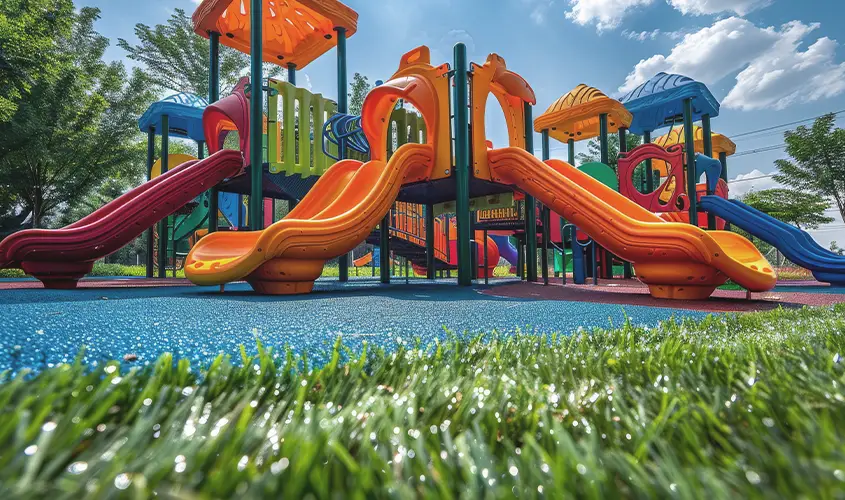
In some cases, it makes sense to mix and match surfacing materials across a single playground. For example, schools might use poured rubber under high-impact zones like swings or slides, while filling in open play areas with engineered wood fiber or bonded mulch.
This kind of hybrid approach can:
- Improve cost-efficiency
- Reduce wear in high-use zones
- Add sensory variety and visual interest
As long as each surface type is installed to spec, mixing materials can be a smart way to stretch a budget while still meeting all safety and accessibility goals.
The Bottom Line
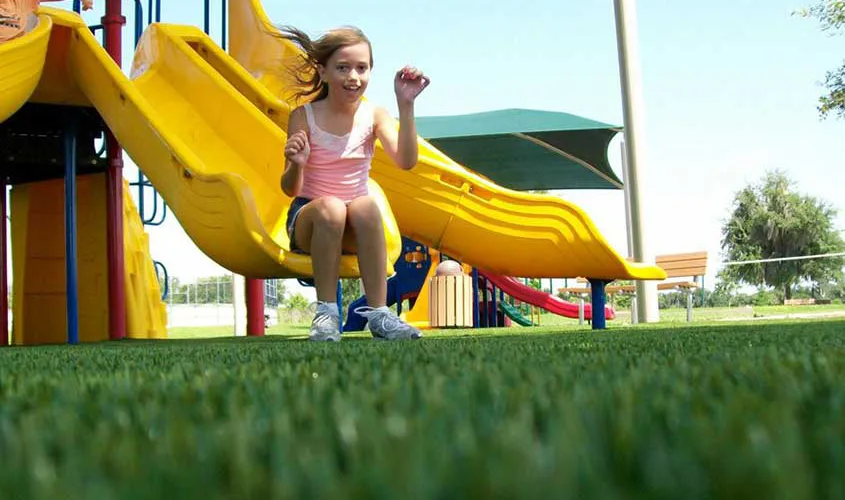
The best playground surface for a school depends on specific priorities.
Schools working within a limited budget often turn to engineered wood fiber for its low upfront cost, though it requires frequent maintenance to remain safe and compliant. For those prioritizing long-term durability and minimal upkeep, surfaces like synthetic turf or poured-in-place rubber typically offer better value over time.
Accessibility is another key consideration. Unitary surfaces—such as turf, poured rubber, and bonded rubber mulch—are generally the most ADA-compliant and easiest to navigate for students with mobility challenges. For schools seeking a natural aesthetic, bonded rubber mulch provides that look with far less maintenance than loose-fill options.
In high-traffic environments, investing in a more durable, low-maintenance surface can reduce long-term repair needs and ensure consistent safety. And in some cases, combining materials strategically—for example, using poured rubber under high-impact zones and wood fiber elsewhere—can offer a practical balance between cost and performance.
Ultimately, the right choice comes down to aligning surface type with your school’s budget, usage patterns, accessibility needs, and maintenance capacity.
At American Greens, we specialize in installation of playground surfaces that meet and exceed ADA requirements. If you’re in the market for playground surfacing, start by getting in touch with us. We’d love the opportunity to show you why school administrators have trusted American Greens with their synthetic playground surfacing needs since 1999.

